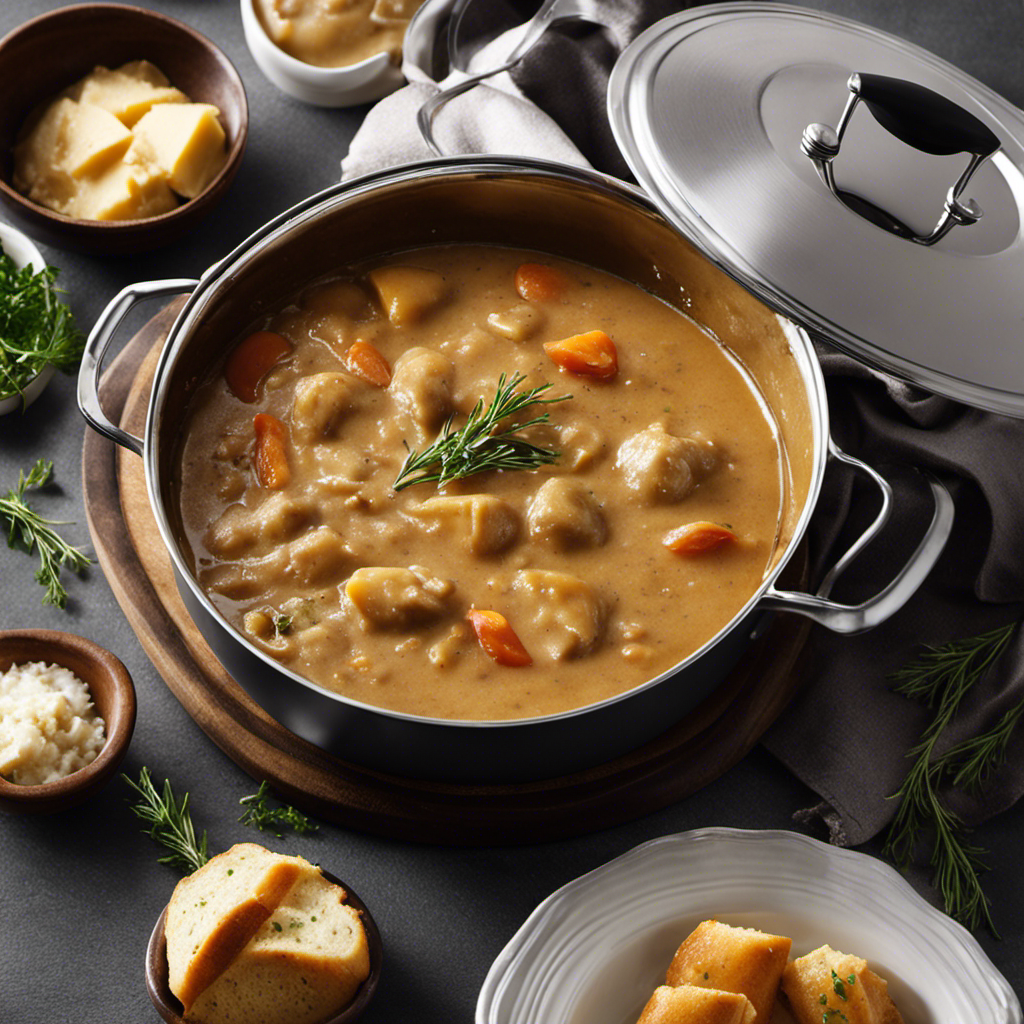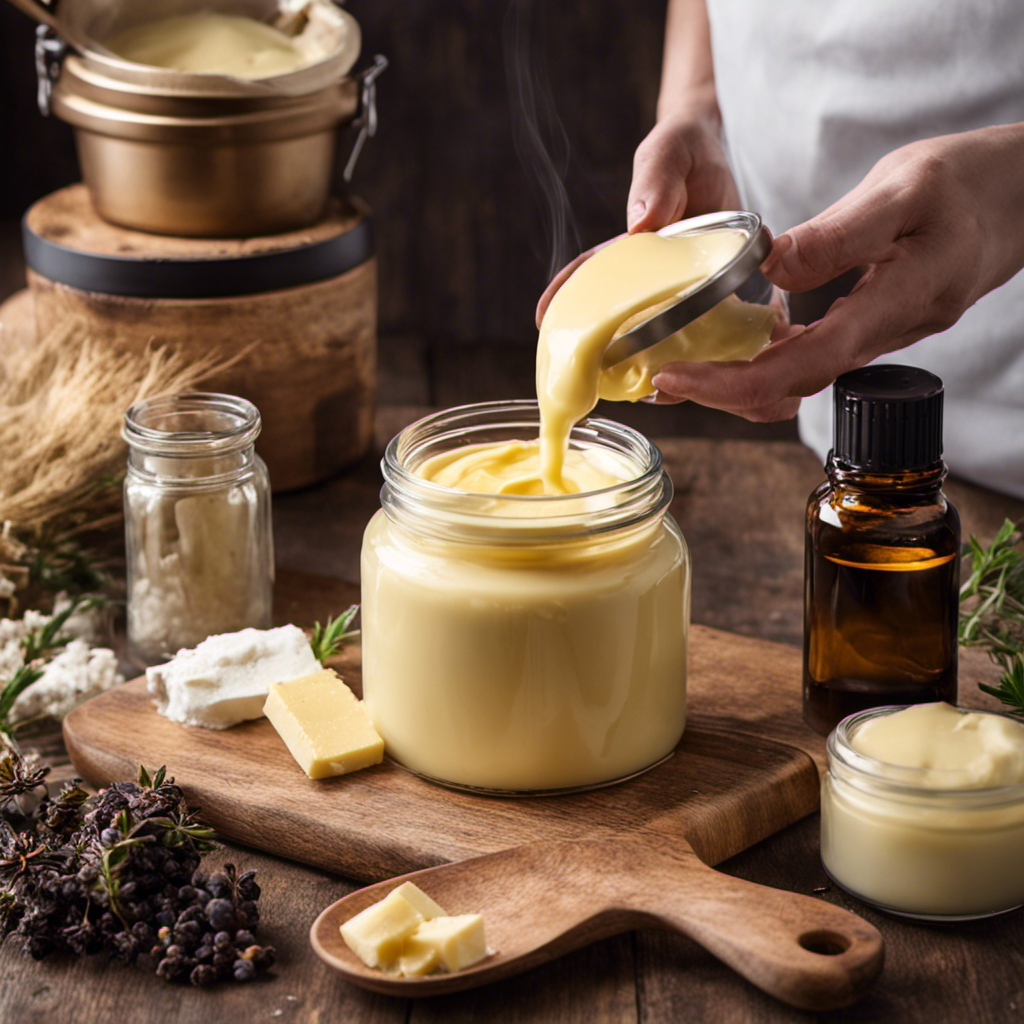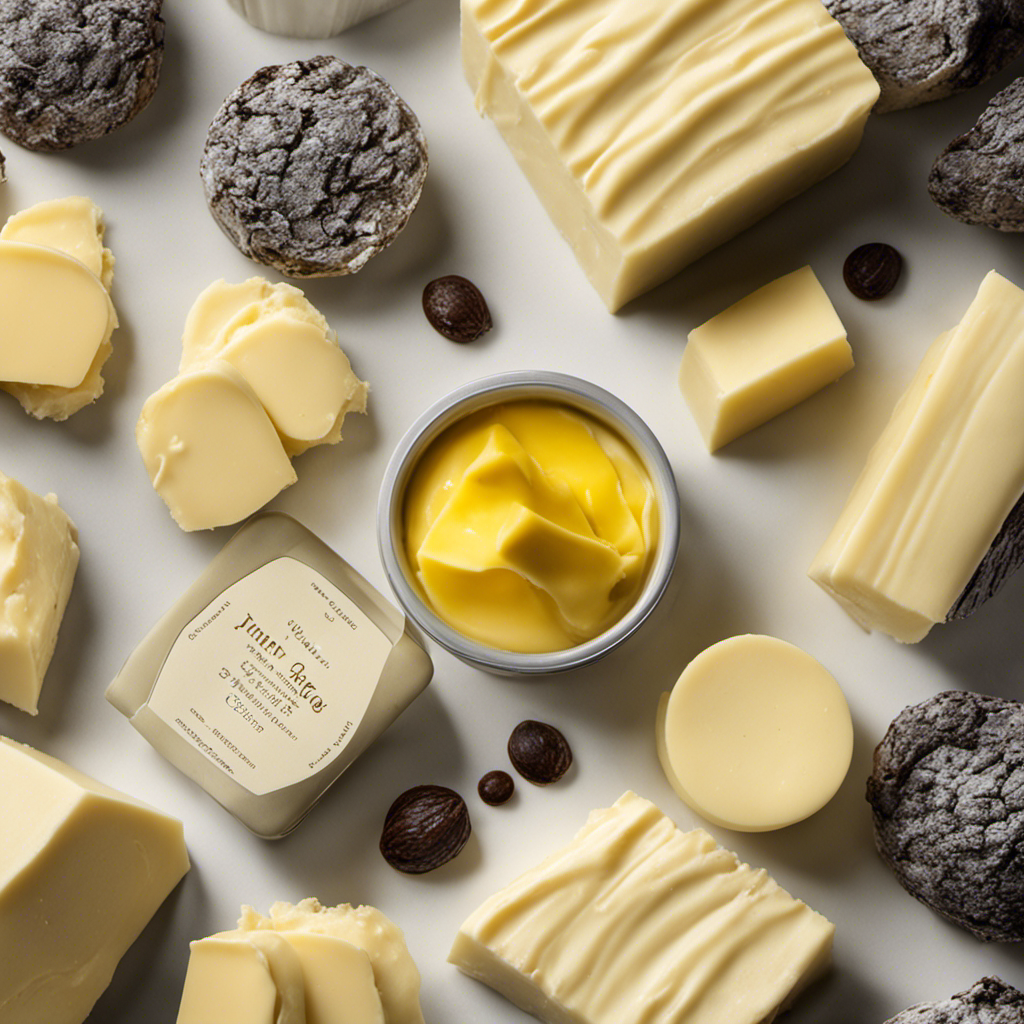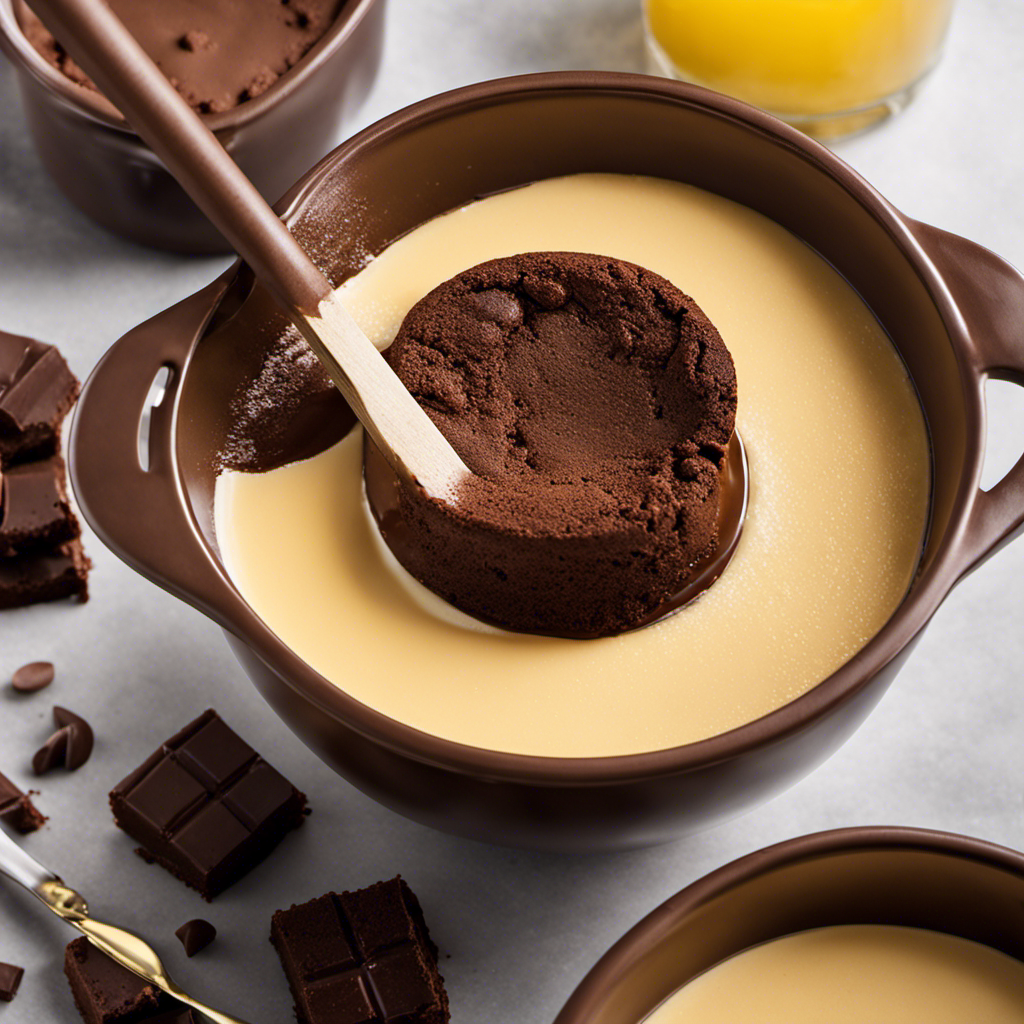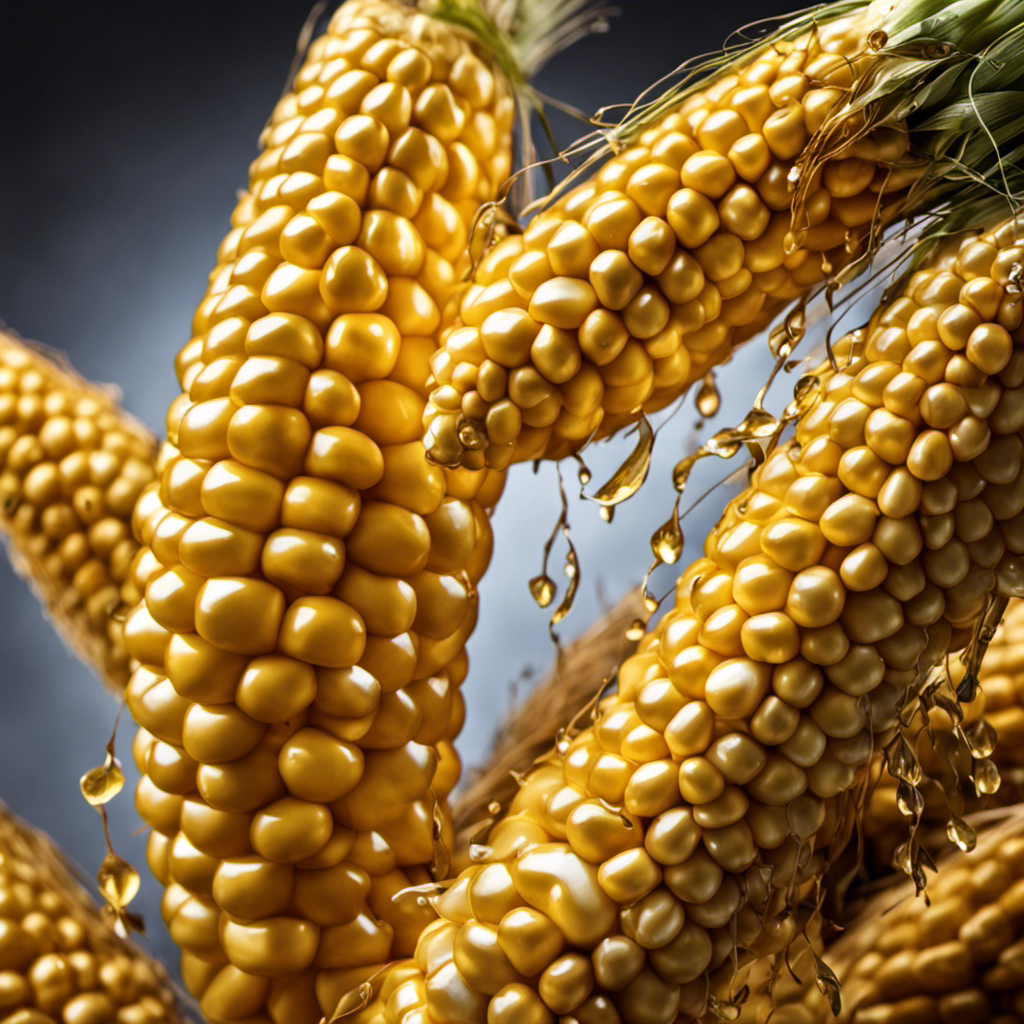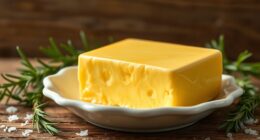I have a secret to share with you – crafting homemade gravy is akin to creating a work of art.
With just flour, water, and butter, you can create a rich and savory sauce that will elevate any meal to new heights.
In this article, I’ll guide you through the process step by step, sharing all my tips and tricks along the way.
Get ready to impress your taste buds and become a gravy-making pro in no time!
Key Takeaways
- Sift the flour before adding it to the pan to break up clumps.
- Use chicken or beef broth instead of water for a richer taste.
- Gradually add water to the roux for a smooth, creamy gravy.
- Consider alternative thickening agents like cornstarch or arrowroot powder.
Gather the Ingredients
You’ll need to gather the flour, water, and butter for making the gravy. To achieve a smooth and lump-free gravy, it’s important to use the right techniques.
First, make sure to sift the flour before adding it to the pan. This helps to break up any clumps and ensures a smooth consistency.
Next, slowly add the water while whisking continuously. This helps to prevent lumps from forming.
As for enhancing the flavor, there are many creative ways to do so. You can add a splash of Worcestershire sauce for a tangy kick, or a sprinkle of herbs like thyme or rosemary for a savory twist. Another option is to use chicken or beef broth instead of water for a richer taste.
Don’t be afraid to experiment and find what flavors work best for you.
Make a Roux With Flour and Butter
To create a roux, all you need is a mixture of flour and melted butter. A roux is a key ingredient in making delicious gravy. It acts as a thickening agent and adds a rich, velvety texture to your gravy.
One of the benefits of using a roux in gravy is that it helps to prevent lumps from forming. It ensures that your gravy has a smooth consistency. Another benefit is that the different types of roux can be used to make various gravies.
A light roux, made with equal parts flour and butter cooked for a short time, is perfect for a delicate chicken or turkey gravy. A dark roux, cooked until it turns a deep brown color, is great for rich, flavorful gravies like beef or lamb.
Now that we have our roux ready, let’s gradually add water to it to create a smooth, creamy gravy.
Gradually Add Water to the Roux
Once the roux is prepared, simply add water gradually for a smooth, creamy consistency.
Making gravy from scratch is a culinary art that can elevate any dish to the next level. There are different types of gravy recipes, such as turkey gravy, beef gravy, and vegetarian gravy, each with its own unique flavors and textures.
To ensure a smooth gravy, here are some tips to keep in mind. First, whisk the water into the roux slowly, allowing it to incorporate fully before adding more. This will prevent lumps from forming and result in a velvety texture. Additionally, make sure the water is warm or hot, as cold water can cause the roux to seize up.
Cook and Thicken the Gravy
Now, it’s time to cook the mixture until it thickens to the desired consistency. Cooking the gravy is where all the flavors come together and the magic happens. To achieve the perfect thickness, you’ll need to use the right cooking techniques and possibly consider alternative thickening agents.
The most common technique for thickening gravy is to simmer it over low heat while stirring constantly. This helps to activate the starch in the flour, which thickens the liquid. Be patient and keep stirring until you reach the desired thickness.
If you’re looking for alternative thickening agents, there are a few options to consider. Cornstarch, arrowroot powder, or even instant mashed potatoes can be used instead of flour. These alternatives are gluten-free and can yield a smoother texture.
Season and Serve the Gravy
When serving the gravy, don’t forget to taste and adjust the seasoning to your liking. This step is crucial in making sure your gravy has the perfect balance of flavors.
Once you’re satisfied with the seasoning, it’s time to think about garnishing options. Here are some ideas to elevate your gravy:
- Fresh herbs: Sprinkle some chopped parsley, thyme, or rosemary on top for a burst of freshness.
- Crispy bacon bits: Add a crunchy texture and smoky flavor by scattering some crispy bacon on top.
- Caramelized onions: Sauté some onions until golden brown and sweet, then top your gravy with them for added depth of flavor.
- Grated cheese: For a creamy and indulgent touch, sprinkle some grated cheese on top and let it melt into the gravy.
If you’re looking for alternative thickening agents, consider using cornstarch, arrowroot, or tapioca starch instead of flour. These options can provide a gluten-free alternative and give your gravy a slightly different texture.
Frequently Asked Questions
Can I Use a Different Type of Flour Instead of All-Purpose Flour for Making the Roux?
Yes, you can use a different type of flour for making the roux. There are various options like whole wheat flour or gluten-free flour. Experimenting with different flours can add unique flavors to your gravy.
Can I Substitute Water With Chicken or Vegetable Broth for a Richer Flavor?
Sure, you can substitute water with chicken or vegetable broth to enhance the flavor of your gravy. The broth adds a rich and savory taste that complements the flour and butter. Give it a try!
How Long Should I Cook the Roux Before Adding Water?
Before adding water to the roux, I cook it for a few minutes until it turns a golden brown color. This helps to develop a rich flavor in the gravy. It also prevents the gravy from being too thin.
How Can I Make the Gravy Thicker if It Turns Out Too Thin?
If my gravy turns out too thin, I can use various thickening techniques to fix it. Adding a slurry of flour and water or simmering it longer can help troubleshoot thin gravy and make it thicker.
Can I Add Other Seasonings or Herbs to the Gravy for Additional Flavor?
Sure, you can definitely add other seasonings and herbs to your gravy for extra flavor. Some popular options include garlic, thyme, rosemary, or even a dash of Worcestershire sauce. Experiment and find your perfect blend!
Conclusion
In conclusion, making gravy with flour, water, and butter is a simple and delicious way to enhance your meals.
With just a few basic ingredients and some easy steps, you can create a rich and flavorful gravy to accompany your favorite dishes.
So don’t be afraid to get creative in the kitchen and give this recipe a try. Trust me, your taste buds will thank you!
